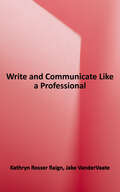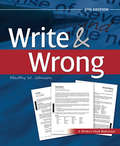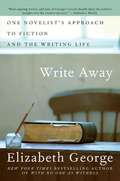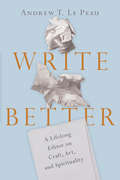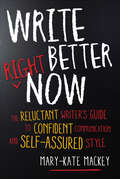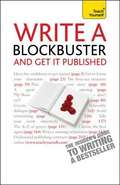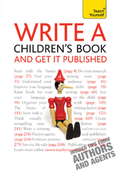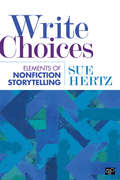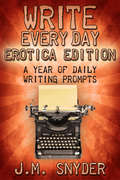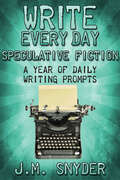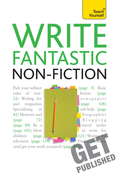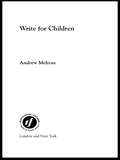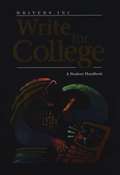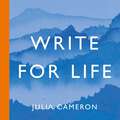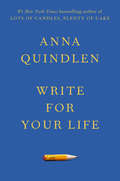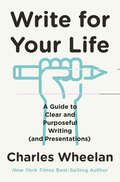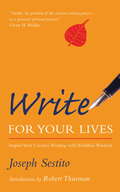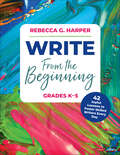- Table View
- List View
Write and Communicate Like a Professional
by Kathryn Rosser Raign Jake VanderVaateThis book is for the introductory technical writing student seeking to improve their writing and communication. The book covers how to improve professional style and tone, develop professional documents, work in teams, and plan and execute multiweek projects. It also includes various types of professional writing―such as letters, texts, handbooks, reports, agendas, press releases, and newsletters―while focusing on those communication forms used most often: emails, memos, and short reports. Authors Kathryn Raign and Jake VanderVaate also cover such important communication skills as collaborative writing in a chapter on sharing and giving feedback. With clear graphics, clever problem-solution rubrics, and the latest coverage of informal technical writing delivered through social media formats of email and text, Write and Communicate Like a Professional is essential reading for your professional success.
Write and Revise for Publication: A 6-Month Plan for Crafting an Exceptional Novel and Other Works of Fiction
by Jack SmithWriters need a structured approach to writing fiction, one that includes effective strategies for both drafting and revision/fine-tuning. A structured approach builds a writer's confidence and provides an efficient process in terms of producing submission-ready work. It's best to get that first draft out there, not worry a lot about how well it's going, and then let it cool a little before getting into the heat of revision and fine-tuning.
Write and Wrong: The only style manual you'll ever need
by Marthy JohnsonEnglish is a blend of passion and logic, except in spelling, which has nothing to do with either. Language is a set of conventions, some of them sensible, and some accidental. Usage is not so much a question of what is right or wrong as of what is or is not accepted. Accepted by whom? By the experts and the committees, and the advisers and the authorities, the stylists, and the grammarists, bless them, who write dictionaries, style guides, textbooks, handbooks, and grammar books in seventy-five volumes. They set limits; decide who has wiggle room and where. Academic writing operates in solitary confinement. Technical writing is medium-security; business writing a work-release effort. Next to them, creative writing is a resort. The only writing manual most writers will ever want -- or need!
Write Away
by Elizabeth GeorgeBestselling author Elizabeth George has spent years teaching writing, and in Write Away she shares her knowledge of the creative process. George combines clear, intelligent, and functional advice on fiction writing with anecdotes from her own life, the story of her journey to publication, and inside information on how she meticulously researches and writes her novels. George's solid understanding of craft is conveyed in the enticing manner of a true storyteller, making Write Away not only a marvelous, interesting, and informative book but also a glimpse inside the world of a beloved writer.
Write Better: A Lifelong Editor on Craft, Art, and Spirituality
by Andrew T. Le PeauWriting is not easy. But it can get better. In this primer on nonfiction writing, Andrew Le Peau offers insights he has learned as a published author and an editor for over forty years, training, guiding, and cheering on hundreds of writers. Here are skills that writers can master—from finding strong openings and closings, to focusing on an audience, to creating a clear structure, to crafting a persuasive message. With wide-ranging examples from fiction and nonfiction, Le Peau also demystifies aspects of art in writing such as creativity, tone, and metaphor. He considers strategies that can move writers toward fresher, more vital, and perhaps more beautiful expressions of the human condition. One aspect of writing that rarely receives attention is who we are as writers and how writing itself changes us. Self-doubt, fear of criticism, downsides of success, questions of authority, and finding our voice are all a part of the exploration of our spirituality as writers found in these pages. Discover how the act of writing can affect our life in God. Whether you're a veteran writer, an occasional practitioner, a publishing professional, or a student just starting to explore such skills, Le Peau's wit and wisdom can speed you on your way.
Write Better Essays in Just 20 Minutes A Day (Second Edition)
by Learningexpress StaffEssay writing need not be daunting. Taking the reader step-by-step through the entire process, from the initial organization of ideas to the final stages of proofreading, Write Better Essays in Just 20 Minutes a Day covers all the essentials: how to understand essay questions, create a strong thesis, develop a captivating introduction, support ideas, and revise the work. Included are plenty of sample essays, strategies for planning and revising in-class essays, ways to overcome writer's block, and tips on achieving higher scores on essay exams.
Write Better Right Now: The Reluctant Writer's Guide to Confident Communication and Self-Assured Style
by Mary-Kate MackeyA veteran writing teacher shares techniques and exercises to help anyone who struggles with written communication create effective and engaging content.In almost any career, you must know how to write—even if it’s not part of your job description. But if you are a reluctant writer, producing even the simplest memo may be a struggle. Write Better Right Now is the springboard to get you ahead in any job, passion project, or situation that requires writing skills. No matter what you are called upon to do—blog posts, speeches, web content, press releases, or more—this step-by-step manual gives you the solid techniques you need to get the task done. Write Better Right Now works because it is:—Short: It takes a concise approach, from first thoughts to final edits, and its mix-and-match structure means you only have to read the sections you need.—Practical: It is loaded with summations, short cuts, tips, cheat sheets, and hands-on exercises.—Solution-driven: Knowing where you’ve gone wrong is half the battle. Write Better Right Now offers you the tools to identify your own problem patterns and choose the quickest and most appropriate fixes. You can improve your writing today.With straightforward guidance, Write Better Right Now is the quick read for productive people who need to create clear and crisp communication—right now.
Write A Blockbuster - And Get It Published: Teach Yourself
by Helen CornerDesigned for all those wanting to be the next Dan Brown, this introduction to writing popular fiction will be a key addition to the writer's bookshelf. Authored jointly by a literary consultant/agent and a highly successful author, it offers not simply a guide to writing a novel but an introduction to writing a plot-based, action-focused blockbuster. It covers such key practicalities as the importance of plot, pace, action, character and the different demands of such popular commercial genres as romantic fiction, thrillers and so on. For those looking to write for a living, this book provides vital information on the process, including finding an agent and making a living as a writer. NOT GOT MUCH TIME? One, five and ten-minute introductions to key principles to get you started. AUTHOR INSIGHTS Lots of instant help with common problems and quick tips for success, based on the authors' many years of experience. TEST YOURSELF Tests in the book and online to keep track of your progress. EXTEND YOUR KNOWLEDGE Extra online articles at www.teachyourself.com to give you a richer understanding of how to write a blockbuster. FIVE THINGS TO REMEMBER Quick refreshers to help you remember the key facts. TRY THIS Innovative exercises illustrate what you've learnt and how to use it.
Write A Children's Book - And Get It Published: Teach Yourself
by Allen Jones Lesley PollingerDesigned for writers of any children's literature, be it fiction, non-fiction or faction, this popular and successful title has been fully updated and expanded to include the latest developments in the field of children's publishing. You will understand the implications of television and film projects, learn new ways of producing your work, the latest technologies and even how to self-publish, guided by two authors who are highly experienced with the genre. NOT GOT MUCH TIME? One, five and ten-minute introductions to key principles to get you started. AUTHOR INSIGHTS Lots of instant help with common problems and quick tips for success, based on the authors' many years of experience. TEST YOURSELF Tests in the book and online to keep track of your progress. EXTEND YOUR KNOWLEDGE Extra online articles at www.teachyourself.com to give you a richer understanding of writing for children. FIVE THINGS TO REMEMBER Quick refreshers to help you remember the key facts. TRY THIS Innovative exercises illustrate what you've learnt and how to use it.
Write A Children's Book - And Get It Published: Teach Yourself
by Lesley Pollinger Allen Frewin JoneDesigned for writers of any children's literature, be it fiction, non-fiction or faction, this popular and successful title has been fully updated and expanded to include the latest developments in the field of children's publishing. You will understand the implications of television and film projects, learn new ways of producing your work, the latest technologies and even how to self-publish, guided by two authors who are highly experienced with the genre.NOT GOT MUCH TIME?One, five and ten-minute introductions to key principles to get you started.AUTHOR INSIGHTSLots of instant help with common problems and quick tips for success, based on the authors' many years of experience.TEST YOURSELFTests in the book and online to keep track of your progress.EXTEND YOUR KNOWLEDGEExtra online articles at www.teachyourself.com to give you a richer understanding of writing for children.FIVE THINGS TO REMEMBERQuick refreshers to help you remember the key facts.TRY THISInnovative exercises illustrate what you've learnt and how to use it.
Write Choices: Elements of Nonfiction Storytelling
by Susan Sue HertzDeveloping nonfiction writers at any stage of their career Write Choices: Elements of Nonfiction Storytelling helps writers cultivate their nonfiction storytelling skills by exploring the universal decisions writers confront when crafting any kind of factual narrative. Rather than isolating various forms of narrative nonfiction into categories or genres, Sue Hertz focuses on examining the common choices all true storytellers encounter, whether they are writing memoir, literary journalism, personal essays, or travel essays. And since today’s writers are no longer confined to paper, Write Choices also includes digital storytelling options, and how writers can employ technology to enhance their narratives. Integrating not only her own insights and experience as a journalist, nonfiction book author, and writing instructor, but also those of other established nonfiction storytellers, both print and digital, Hertz aims to guide writers through key decisions to tell the best story possible. Blending how-to instruction with illuminating examples and commentaries drawn from original interviews with master storytellers, Write Choices is a valuable resource for all nonfiction writers, from essayists to memoirists to literary journalists, at any stage of their career.
Write Choices: Elements of Nonfiction Storytelling
by Susan Sue HertzDeveloping nonfiction writers at any stage of their career Write Choices: Elements of Nonfiction Storytelling helps writers cultivate their nonfiction storytelling skills by exploring the universal decisions writers confront when crafting any kind of factual narrative. Rather than isolating various forms of narrative nonfiction into categories or genres, Sue Hertz focuses on examining the common choices all true storytellers encounter, whether they are writing memoir, literary journalism, personal essays, or travel essays. And since today’s writers are no longer confined to paper, Write Choices also includes digital storytelling options, and how writers can employ technology to enhance their narratives. Integrating not only her own insights and experience as a journalist, nonfiction book author, and writing instructor, but also those of other established nonfiction storytellers, both print and digital, Hertz aims to guide writers through key decisions to tell the best story possible. Blending how-to instruction with illuminating examples and commentaries drawn from original interviews with master storytellers, Write Choices is a valuable resource for all nonfiction writers, from essayists to memoirists to literary journalists, at any stage of their career.
Write Every Day: 365 Daily Prompts for Writers (Write Every Day #1)
by J. M. SnyderWriting prompts are a great way to jumpstart your muse and get the creative juices flowing. Sometimes you want to write and don’t really know what to write about, and prompts can help guide you into a new story.This collection of 366 writing prompts can be used daily throughout the year (leap years, too!) as a starting point to get you writing ... andkeepyou writing. Each day of the year has its own, unique prompt. Set a timer for fifteen or twenty minutes, and write wherever the prompt takes you. Or, if you’re between stories and looking for something different to work on, flip to the prompt for today (or any random page) and start fresh.This book will kick-start your writing or take you in exciting new directions every day of the year!
Write Every Day Erotica Edition: A Year of Daily Writing Prompts (Write Every Day #2)
by J. M. SnyderLast year, I published a book of writing prompts to help jumpstart muses and get the creative juices flowing. Many of the prompts that didn’t make the cut in that book were salacious, to say the least. As an erotica writer, I sometimes like to think outside my own boundaries and try to tackle the art of writing sex in new and exciting ways. Let’s be honest -- there are only so many things you can say about sex before you start feeling as if the scene has become rote or mechanical. The romance of your first sex story soon dulls with time, almost like a marriage, and you’re left wondering what happened to the excitement you felt when you first fell in love with writing about ... well, love. That’s why I decided to write a book of writing prompts geared specifically towards the erotica writer. Maybe you want a different position, or a new way of thinking about a familiar scene. Maybe you want to try your hand at something you’ve never dared write before. Maybe you just want to write about two people getting it on and don’t really know where to begin.This collection of 366 writing prompts can be used daily throughout the year (leap years, too!) as a starting point to get you writing ... and keep you writing. Each day of the year has its own, unique prompt. Set a timer for fifteen or twenty minutes, and write wherever the prompt takes you. Or, if you’re between stories and looking for something different to work on, flip to the prompt for today (or any random page) and start fresh.This book will kick-start your writing or take you in exciting new directions every day of the year!
Write Every Day Speculative Fiction Edition: A Year Of Daily Writing Prompts
by J. M. SnyderThe next installment of J.M. Snyder's popular Write Every Day series focuses on speculative fiction. There are many subgenres -- paranormal, dystopian, space opera, splatterpunk, alternate history, magic realism, high fantasy ... the list goes on. Anything fantastical or futuristic qualifies as spec fic, too. Whether you’re already writing speculative stories or you’re looking to get into them, this is the book for you!This collection of 366 writing prompts can be used daily throughout the year (leap years, too!) as a starting point to get you writing ... and keep you writing. Each day of the year has its own, unique prompt. Set a timer for fifteen or twenty minutes, and write wherever the prompt takes you. Or, if you’re between stories and looking for something different to work on, flip to the prompt for today (or any random page) and start fresh.This book will kick-start your writing or take you in exciting new directions every day of the year!
Write Fantastic Non-fiction - and Get It Published: Teach Yourself
by Claire Gillman""Write Fantastic Non-fiction and get it Published"" is designed specifically for you, if you want to turn your idea into a book. If you're wondering where to start, this book clearly explains how to select a subject, hone your research skills, explore different genres and styles and edit your work. It does more than simply review the different genres, however - it will, crucially, help you to master the skill of assessing your own work objectively - essential for any would-be writer. With your confidence strengthened through practical tips, insights and exercises, it will also give you the crucial insider information on and how to approach a publisher or find an agent. Written by an author with a track record of helping new writers secure agents and publishing deals, it will take you from 'would-be writer' to 'writer' quickly and painlessly
Write for Children: Exploring Contemporary Issues In Writing For Children
by Andrew MelroseWriting for children is not about writing little stories, it is about writing big stories, shorter. Children's literature is an art form in its own right, and this book is for everyone who wants not just to write for children, but to write well for them. This short guide to creative writing for children is based on the author's own successful MA course. Andrew Melrose provides guidance on every aspect of the process of writing for children. He stresses the importance of 'writing for' the child and not 'writing to or at' them. Literacy and learning depend on writing and reading and it is therefore the responsibility of the writer to understand who they are writing for. The book is divided into four sections which cover all aspects of the writing process.This book goes far beyond the 'how to' format to help writers learn the finely balanced craft of writing for children. It will be an indispensable handbook for aspiring and practising children's authors.
Write for College: A Student Handbook
by Patrick Sebranek Verne Meyer Dave KemperWrite for College emphasizes the kinds of writing most often asked for in college courses. But the handbook covers much more than writing. It also provides information and guidelines for speaking, thinking, test taking, studying, researching, and nearly every other topic essential to success in college.
Write for Life: A Toolkit for Writers
by Julia CameronLegendary author of The Artist's Way Julia Cameron has pioneered the field of creative recovery, inspiring millions of people around the world to discover their true creative selves. Now in Write for Life, the 'Queen of Creativity' speaks directly to writers - it is an openhearted invitation to begin, stick with, and finish a project.Write for Life delivers a wonderful balance of firm and inspiring advice, shaped into a 6-week program for writers of all levels. From setting daily writing quotas to changing genres, fighting perfectionism to polishing a first draft, Julia Cameron provides holistic guidance and support every step of the way.Write for Life is for every writer, and every writer should have it. It is Julia Cameron at her best, distilling decades of wisdom and experience in practical lessons on the craft and spiritual practice of writing. It is an unmissable addition to Julia Cameron's creative canon, destined to sit in the pantheon of classic works on writing.
Write for Life: Creative Tools for Every Writer (A 6-Week Artist's Way Program)
by Julia CameronA 6-Week Artist’s Way ProgramJulia Cameron has been teaching the world about creativity since her seminal book, The Artist’s Way, first broke open the conversation around art. Now, in Write for Life, she turns to one of the subjects closest to her heart: the art and practice of writing.Over the course of six weeks, Cameron carefully guides readers step by step through the creative process. This latest guide in the Artist’s Way Series:- Introduces a new tool and expands on powerful tried and true methods. - Gently guides readers through many common creative issues — from procrastinating and getting started, to dealing with doubt, deadlines, and “crazymakers.”- Will help you reach your goals, whether your project is a novel, poetry, screenplay, standup, or songwriting.With the learned experience of a lifetime of writing, Cameron gives readers practical tools to start, pursue, and finish their writing project. Write for Life is an essential read for writers who have completed The Artist’s Way and are looking to continue their creative journey or new writers who are just putting pen to paper.
Write for Your Life
by Anna QuindlenIn this clarion call to pick up a pen and find yourself from &“one of our most astute chroniclers of modern life&” (The New York Times Book Review), #1 New York Times bestselling author Anna Quindlen shows us how anyone can write, and why everyone should. What really matters in life? What truly lasts in our hearts and minds? Where can we find community, history, humanity? In this lyrical new book, the answer is clear: through writing. This is a book for what Quindlen calls &“civilians,&” those who want to use the written word to become more human, more themselves. Write for Your Life argues that there has never been a more important time to stop and record what we are thinking and feeling. Using examples from past, present, and future—from Anne Frank to Toni Morrison, from love letters written after World War II to journal reflections from nurses and doctors today—Write for Your Life vividly illuminates the ways in which writing connects us to ourselves and to those we cherish. Drawing on her personal experiences not just as a writer but as a mother and daughter, Quindlen makes the case that recording our daily lives in writing is essential. When we write we not only look, we see; we not only react but reflect. Writing gives you something to hold onto in a changing world. &“To write the present,&” Quindlen says, &“is to believe in the future.&”
Write for Your Life: A Guide to Clear and Purposeful Writing (and Presentations)
by Charles WheelanThe best-selling author’s practical guide to writing clearly and convincingly in every professional setting.?? How would you create a winning pitch for your latest investment idea? Or persuasively argue for a major policy change? Or successfully ask your boss for a raise? The answer: clear and effective communication, whether in writing or through a presentation. Best-selling author Charles Wheelan has spent decades mastering effective communication skills in his work as a writer, college professor, journalist, speechwriter, political candidate, and public speaker. In? Write for Your Life, he shares his best tips. ?Taking readers through all the steps required to arrive at a coherent first draft, he then explains the best ways to improve and fine-tune your writing. He covers how to organize and present information, why it’s necessary to adapt your tone to different audiences, and when to use summaries, sidebars, bullet points, and other tools for making information more digestible. He explores the truth behind popular clichés like “Show, don’t tell” and “Kill your darlings,” and discusses the proper use and attribution of quotations from secondary sources.?And he goes on to cover how to speak effectively, providing helpful advice for preparing a winning presentation or delivering a speech. Writing with his signature wit and humor, Wheelan illustrates his points with entertaining examples from his own life, as well as memorable anecdotes from leading magazine and newspaper writers, political figures from Winston Churchill to Barack Obama and Elena Kagan, and a diverse array of the best communicators from the worlds of culture, sports, and politics.? Write for Your Life ?is an essential guide for anyone needing to get their ideas across whether in an email, memo, report, presentation, fund-raising letter, or speech.?
Write for Your Lives
by Joseph SestitoThis practical guide to successful creative writing uses cognitive behavioural therapy and spiritual strategies to help people liberate themselves to achieve optimal productivity and enjoyment.
Write From the Beginning, Grades K–5: 43 Joyful Lessons to Foster Skilled Writers Every Day
by Rebecca G. HarperDiscover engaging lessons to transform your elementary writing instruction While we sometimes perceive that our students aren’t "ready to write", every student brings literacy experiences from their home and family lives that can be leveraged to create meaningful writing experiences in the first days of school. Write From the Beginning, Grades K–5 empowers educators to cultivate a vibrant writing culture in their classrooms, where students can find their voices and flourish as confident writers. Getting better at any skill requires practice to gain experience. This rich resource offers opportunities for daily writing that easily embed in your ELA block, helping you save on prep time and build your students’ literacy foundations. Through a collection of 43 meticulously crafted lessons, Rebecca G. Harper melds standards-based instruction with innovative writing strategies, guiding young learners to explore the art of crafting sentences, storytelling, writing persuasively, and finding their voice as a writer. Designed to engage students in joyful and meaningful writing activities, this book Transforms writing into a real-world activity for students, providing an authentic and relevant view of the complex writing process Offers adaptable lessons that align with developmental stages and instructional goals to meet students where they are in their writing journey Highlights the significance of digital literacy in today′s world and how it can be incorporated into the classroom Includes student samples, downloadable resources, mentor texts, and lesson plan extensions for easy implementation With a focus on the characteristics of skilled writing rather than rigid genres, this book is a versatile resource that enriches any curriculum or writing instruction model. Dive into Write From the Beginning, Grades K–5 and watch your students′ writing skills blossom with creativity and confidence.
Write From the Beginning, Grades K–5: 43 Joyful Lessons to Foster Skilled Writers Every Day
by Rebecca G. HarperDiscover engaging lessons to transform your elementary writing instruction While we sometimes perceive that our students aren’t "ready to write", every student brings literacy experiences from their home and family lives that can be leveraged to create meaningful writing experiences in the first days of school. Write From the Beginning, Grades K–5 empowers educators to cultivate a vibrant writing culture in their classrooms, where students can find their voices and flourish as confident writers. Getting better at any skill requires practice to gain experience. This rich resource offers opportunities for daily writing that easily embed in your ELA block, helping you save on prep time and build your students’ literacy foundations. Through a collection of 43 meticulously crafted lessons, Rebecca G. Harper melds standards-based instruction with innovative writing strategies, guiding young learners to explore the art of crafting sentences, storytelling, writing persuasively, and finding their voice as a writer. Designed to engage students in joyful and meaningful writing activities, this book Transforms writing into a real-world activity for students, providing an authentic and relevant view of the complex writing process Offers adaptable lessons that align with developmental stages and instructional goals to meet students where they are in their writing journey Highlights the significance of digital literacy in today′s world and how it can be incorporated into the classroom Includes student samples, downloadable resources, mentor texts, and lesson plan extensions for easy implementation With a focus on the characteristics of skilled writing rather than rigid genres, this book is a versatile resource that enriches any curriculum or writing instruction model. Dive into Write From the Beginning, Grades K–5 and watch your students′ writing skills blossom with creativity and confidence.
